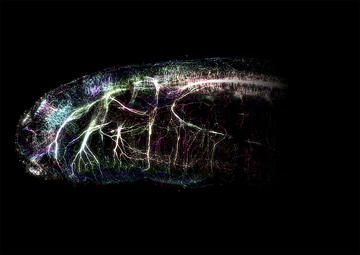
The cranial nerves in a lamprey embryo, showing just how complicated the sensory systems of even the most ancient of vertebrates was
Image credit: V Papadogiannis
Manipulating the genes of ‘relict’ species has revealed an ancient genetic circuit that governs the development of the nervous system cells that feed sensory input into the brain. This shows that vertebrate head sensory systems originally evolved from genetically similar but scattered cells in the skin of a distant pre-vertebrate ancestor.
The evolution of vertebrates around 500 million years ago was one of the most important changes in life on Earth. It was also a key step in our own evolutionary story. Understanding how vertebrates evolved their unique features and became so successful has been a long-term goal of evolutionary biologists. The newly-published research adds another piece to this puzzle.
The first vertebrates displayed features that underlie the success of their descendants. These included sophisticated sensory systems mediating sight, hearing, balance, pain and smell. Together, these supported the evolution of vertebrates from sea-bottom filter feeders to active terrestrial predators. But what genetic changes lead to these innovations?
To travel through evolutionary time and study organisms very similar to those early vertebrates, the team studied some surviving ‘relict’ groups of animals – lampreys, sea squirts, and amphioxus. Combined, they offer a window into the genetic history of this period.
The researchers looked at how key gene family, known as Hmx, controls the development of sensory cells in the head. They manipulated how Hmx genes are expressed and regulated, and showed how these genes are required for sensory cells to develop and can also force other cells to change their program. By doing this in several species they were able to see how the system had evolved.
To their surprise, they found that regulation of the Hmx gene was also conserved in sea squirts, which don’t have much in the way of head sensory cells, or even a backbone or a brain. This proved that the whole system predated vertebrates by many millions of years. The regulatory circuit is more deeply conserved than previously thought, shared among all vertebrates currently living today.
Next, the team want to work out just how far this conservation goes. How many other genes are involved? What do they do? And how do they guide the development of the head sensory cells that in us allow us to hear, smell, sense pain and temperature and control our body’s internal state?
“Our work shows the power of applying new genetic methods to old evolutionary questions. In doing so we can not only see what has changed over evolutionary time but also establish how this happened, and what it meant for the way cells and organs develop”
Sebastian Shimeld
To read more about this research, published in Nature, please visit: https://www.nature.com/articles/s41586-022-04742-w